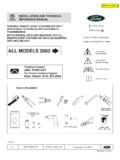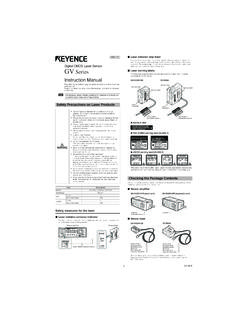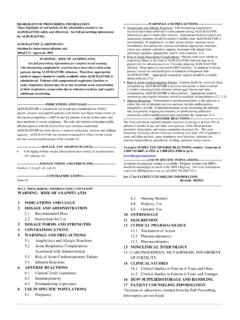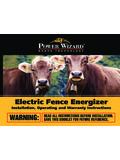Transcription of 1. Warning
1 Reefs which are located on the East Coast of Florida from Sebastian to Inlet are generally shallow - anywhere from 6 ft to 20 ft in depth. When conditions are favorable (calm seas with little or no swells) there are many locations which can be accessed from the shore. When the sea is rough, these areas can be dangerous and usually provide no visibility when there is any type of swell or wave. This is because shallowness of the reefs and the fact that there is no filtering effect of the water. Clarity is generally due to a calm, flat sea where the turbidity settles to the bottom. A calm sea is usually due to west winds or a southwest wind which gives us a bit of a current pushing in the clearer Gulf Stream waters. The weather conditions are so unpredictable in these areas that one can hardly plan on making a scheduled dive.
2 Most is done sporadically or during a clear spell. Calling for dive conditions is always recommended. Or Sign up for the Clear Water reports at we will send you an E-Mail of thedive conditions for their respective. The Following is a listing of known dive sites accessible by public and semi public beaches. Semi public meaning that there may or may not be parking nearby, but if found, you can walk to the beach via an accessible walkway. Remember, a diver down flag is required at all times while persons with snorkeling or scuba equipment are in the water. Salt water licenses are required for collecting. 1. Sebastian Inlet N. & S. Jetty (15 mi. N. of on SR A1A) Warning : This is a state park and a navigable inlet. It is hazardous due to boats, fishing line, and strong tidal currents.
3 Popular with jet skiers, sail boarders and surfers. Divers should be warned this is a hazardous area and is not recomended for sport diving. 2. Inlet Cove Tidal Pool (15 mi. N. of on SR A1A) Located on the North Side of the Inlet State Park is a shallow tidal pool with a sand bottom composition teeming with tropical fish, crabs, starfish, shells, shrimp, squid and lobster. There is a small rock jetty enclosing the pool with a 200 ft. wide opening into the inlet. Manatees are commonly seen swimming in the pool. The area is safe as long as you stay well inside the rock boundary, especially during an out going tide. Going too close to the edge of the jettycould be very dangerous causing one to be pulled too far off shore with the safest time to explore this tidal pool is during an in-coming high tide, as the current is then moving toward the shore line.
4 Young snorkelers should be supervised at all times. 3. Sebastian South Beach Park (14 mi. N. of Rt. 60 on SR A1A) This is one of the newest parks, with plenty of parking. The reef is close to the shoreline with only 3 to 6 feet of depth on the first and second reefs. The reef line extends as far out as 200 yards where the depth reaches approximately 20 feet. With the inlet less than one mile away, tidal currents are strong, out-going tides may bring debris causing poor vis. 4. El Capitana Wreck & Museum ( mi. N. of Rt. 60 on SR A1A) Museum is about the 1715 Silver Plate Fleet Wrecks run by the State. It s neat and interesting; worth the entry fee. This is a semi public access for you cannot dive directly from the museum due to a large rock sea wall that blocks access, but if you park along the river just north of the museum, you will see trails that lead to the beach.
5 Be prepared for a walk. The reef is 20 feet from the beach in 3 to 6 feet of water and further from shore reaches 20 ft deep. This is a state wreck site and in-water salvaging is illegal. One may stumble accross a cannon or cannon ball. Remember, these wrecks were wooden ships which have deteriorated completly, the only remnants being made of metal and stone. 5. Indian River County Access ( N. of Rt. 60 on SRAiA) There are numerous accessess similar to this with limited parking (from 2- 6 cars, paved and unpaved). Caution should be used to avoid getting your car stuck in areas with soft sand. This particular area has access tucked between two private your car stuck in areas with soft sand. This particular area has access tucked between two private beach homes, so it is easy to miss if you don t watch for it carefully as you drive along A1A.
6 Just north of the museum along State Road A1A, there is only soft sand parking, so use caution. This is the closest access to the Green House wreck and is a popular site for people using metal detectors on the beach. The reef is close to shore, reaching a depth of 20 ft. as you progress out to Sea 6. Golden Sands ( mi. N. of Rt. 60 on SR A1A) The newest public beachs with facilities, ample parking, and life guards. This area is virgin territory with very few divers, except for the treasure salvors. There are more quadrant markers for triangulation along this beach than in any other. The salvors have many a wreck pegged out here. The reef is 10 to 20 feet d e e p approximately 100 feet from the beach. There are several small crevices intertwining through the reef, providing an interesting dive.
7 7. Wabasso/Disney Resort Beach (8 mi. N. of Rt. 60 - on SR A1A and SR 510) SR 510 is the closest acess from the north via US1 oe Interstate 95 to all the public beach dive sites from Sebastian Inlet area, all the way down through Vero Beach to Ft. Pierce Inlet State Park. This beach dive site has good parking with facilities, it is right next door to the Walt Disney Beach Resort. The reef is very shallow in this area and close to the beach . 8. Sea Grape Beach ( mi. N. of Rt. 60) Limited parking. No facilities. Nestled in between two condominiums complexes. The reef is about 100 fee from the beach. It is a shallow, low lying reef with small ledges. Due to its close proximity to a popular treasure wreck site. Clarity is not always good due to the blower activity of the salvors.
8 9. Turtle Trail ( miles N. of ) Limited parking and no facilities. This is a popular metal detecting area. This is a marked treasure wreck site. Triangulation markers are used by the salvors for locating the treasure sites. The reef is a fair dive site with low lying ledges. To the south, you will see a point jutting out from the shoreline, marking where the reef line is only 50 ft. from it. It is quite shallow in this area, and when the salvors are in the area the clarityis usually poor due to the blowers used for searching. 10. Tracking Station ( N. of Rt. 60) This beach access has life guards, facilities and ample parking. The reef is scrub-like a aproximately 100 ft. from the shore line ranging 15-20 feet in depth. Another 100 ft. from the shore lies a nicer reef with well-defined ledges, affording nice hiding places for the abundant lobsters.
9 Just south, directly in front of the tracking station, is a trans-Atlantic cable, approximately five inches in diameter which extends to Puerto Rico. If you swim to the south, you should cross it. If you are past the tracking station, you missed it. Once on the cable, you may follow it to the east to locate excellent reef structures. 11. Vero Beach Inn and Pier ( miles Rt. 60) Private beach with a pier to the north. The reef begins approximately 150 feet from the beach with good ledges. Caution should be taken nearthe pier to avoid entanglement in fishing lines, both underwater and on the surface. 12. Jaycee and Conn Beach (1 mile Rt. 60) Nearly one mile long with a boardwalk extending from one end to the other, this is the largest beach area in Vero Beach. Facilities are locatedin Jaycee Park on the north end of the beach, where there are also life guards and ample parking.
10 The reef is unique in the area with a wide variety of shapes and interesting formations. Within 100 feet from shore is a low-lying ledge with flat areas good for lobstering. From 150 to 300 feet from shore, there are large swim through areas with cave-like openings. On the south end,there are flat rock formations that slope to within five feet of the surface with the maximum depth of 20 feet. This is an excellent reef for divers whether exploring or hunting. It is highly recommended that a surface float be carried in addition to the required dive flag. 13. Breconshire Wreck (BoilerWreck) (Sexton Plaza, end of Rt. 60) Between the Holiday Inn and Ocean Grill Restaurant is the Sexton Plaza, a drive-through parking lot overlooking the ocean. About 300 feet from the beach is a large boiler protruding through the water visible from the shore.




